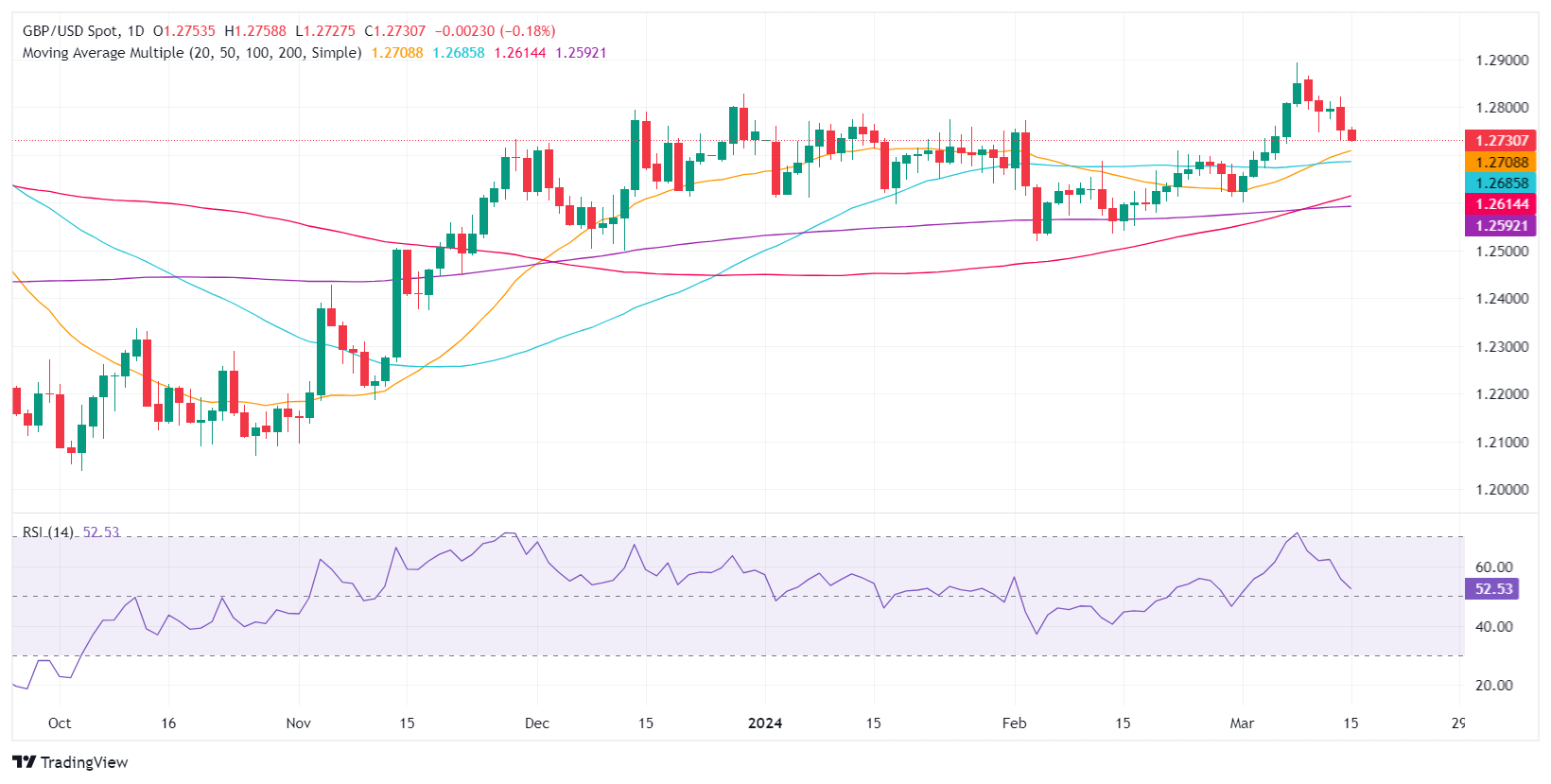GBP/USD resumes a downtrend amid softish US data
- GBP/USD falls as US inflation data and retail sales reinforce a less dovish Fed outlook.
- Industrial Production in the US shows signs of recovery, contributing to the US Dollar’s resilience.
- UK labor market report influences BoE rate cut speculations, with attention on June's monetary policy.
- Market anticipation builds for next week’s Fed and BoE meetings, with inflation data set to impact GBP/USD.
The Pound Sterling is set to finish the week with losses, yet extended its downtrend for two straight days after piercing the 1.2800 figure. The GBP/USD exchanges hands at 1.2731, post losses of 0.16%.
GBP/USD retreats below 1.2800, exposing critical support levels after hot US inflation
The Greenback remains bid as traders trimmed their bets of a dovish Federal Reserve. The US Department of Labor revealed February’s consumer and producer inflation data, with figures suggesting that prices remain elevated, unable to break below the 3% threshold. In the meantime, a solid Retail Sales report failed to exceed estimates but showed an improvement compared to the prior month’s reading.
Today, the US economic schedule showed that Industrial Production rebounded on February, snapping two months of consecutive deterioration. Manufacturing output came at 0.1% MoM, up from -0.5% contraction in January, and exceeded the consensus according to data revealed by the Fed. Recently, the University of Michigan Consumer Sentiment on its preliminary reading was 76.5, below estimates and the previous reading of 76.9. Americans expect inflation to remain at 3% in the 12 months from March and for five years at 2.9%.
Across the pond, a softish labor market report weakened the Cable. A rise in the unemployment rate and a dip in Average Earnings excluding Bonuses, a measure of wage inflation, dipped from 6.2% to 6.1%. The data sparked markets to ramp up bets on a Bank of England (BoE) rate cut in June.
In the meantime, traders brace for the next week’s monetary policy decisions by the Fed and the BoE. The consensus expect both institutions to hold rates unchanged, though any dovish hints, could trigger a reaction by the financial markets. Traders would also be looking at the release of inflation figures in the UK
GBP/USD Price Analysis: Technical outlook
GBP/USD buyers failed to cling to gains above 1.2800, exacerbating a drop below the latest cycle high of 1.2827, exacerbating a pullback below the 1.2800 handles. That said, key support levels were exposed, like the 50-day moving average (DMA) at 1.2685, followed by the next cycle low seen on March 1 low at 1.2599. once those levels are cleared, the confluence of the 100 and 200-DMAs around 1.2589/1.2601 would be up next.
Pound Sterling FAQs
The Pound Sterling (GBP) is the oldest currency in the world (886 AD) and the official currency of the United Kingdom. It is the fourth most traded unit for foreign exchange (FX) in the world, accounting for 12% of all transactions, averaging $630 billion a day, according to 2022 data. Its key trading pairs are GBP/USD, aka ‘Cable’, which accounts for 11% of FX, GBP/JPY, or the ‘Dragon’ as it is known by traders (3%), and EUR/GBP (2%). The Pound Sterling is issued by the Bank of England (BoE).
The single most important factor influencing the value of the Pound Sterling is monetary policy decided by the Bank of England. The BoE bases its decisions on whether it has achieved its primary goal of “price stability” – a steady inflation rate of around 2%. Its primary tool for achieving this is the adjustment of interest rates. When inflation is too high, the BoE will try to rein it in by raising interest rates, making it more expensive for people and businesses to access credit. This is generally positive for GBP, as higher interest rates make the UK a more attractive place for global investors to park their money. When inflation falls too low it is a sign economic growth is slowing. In this scenario, the BoE will consider lowering interest rates to cheapen credit so businesses will borrow more to invest in growth-generating projects.
Data releases gauge the health of the economy and can impact the value of the Pound Sterling. Indicators such as GDP, Manufacturing and Services PMIs, and employment can all influence the direction of the GBP. A strong economy is good for Sterling. Not only does it attract more foreign investment but it may encourage the BoE to put up interest rates, which will directly strengthen GBP. Otherwise, if economic data is weak, the Pound Sterling is likely to fall.
Another significant data release for the Pound Sterling is the Trade Balance. This indicator measures the difference between what a country earns from its exports and what it spends on imports over a given period. If a country produces highly sought-after exports, its currency will benefit purely from the extra demand created from foreign buyers seeking to purchase these goods. Therefore, a positive net Trade Balance strengthens a currency and vice versa for a negative balance.







